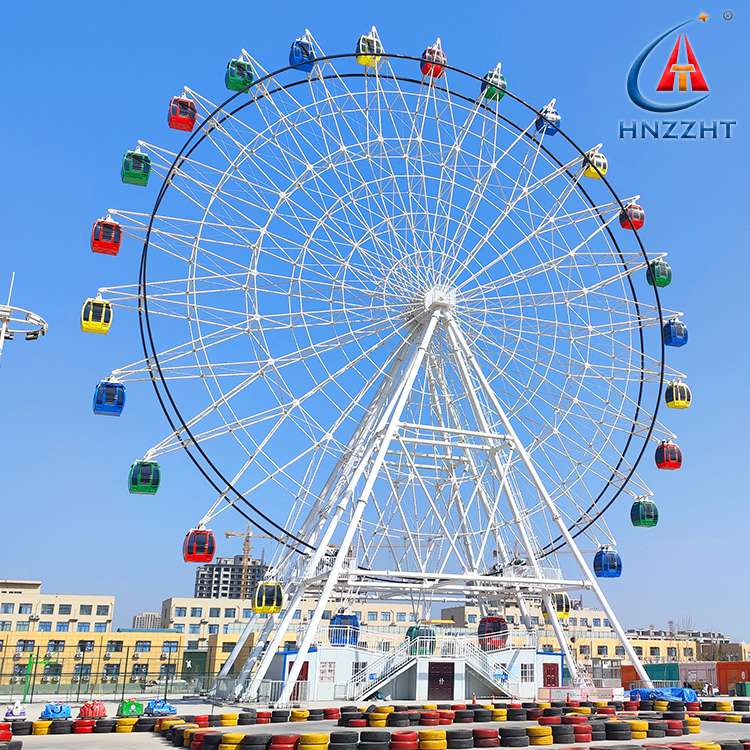How to manage children’s playground equipment well is an important factor to understand and consider in operation management. So, what are the key points of amusement park operation management? Zhengzhou Aerospace Amusement Equipment Manufacturing Co., Ltd. takes the children’s playground equipment Ferris wheel as an example to analyze as follows.

As the operator and manager of a children’s playground, I face many things every day. Under normal operation, taking the Ferris wheel as an example, its operation and management usually include the following key points:
Key point one: Problem handling.
In daily life, maintenance and upkeep should be carried out according to regulations, checked on time and recorded, and any problems or signs should be dealt with promptly. If there is a mechanical failure of the amusement equipment during use, it should be stopped urgently and switched to manual operation, and passengers should be rescued and evacuated one after another according to the provisions of the emergency plan. When there are many tourists on holidays, long queues may form in the courtyard. It is important to maintain order on site and avoid rushing in and out. Reasonable response and handling of these daily issues require rich operational experience and a well-trained workforce.
Key point two: Crisis management.
Crisis management is a series of proactive actions taken by amusement parks to prevent, overcome, and transform crises, maintain the normal operation of park operations, help businesses overcome adversity, avoid or reduce property losses, and turn crises into opportunities. The main focus should still be on avoiding in advance, but when a crisis occurs, action should be taken until the crisis disappears. The types of crises generally include macro level strategic crises and micro level tactical crises. Strategic crises are generally related to the brand competitiveness and equipment layout configuration of amusement parks. Tactical crises include the iteration of amusement equipment such as Ferris wheels, as well as emergencies such as evacuating tourists or suspending some operations due to Ferris wheel failures. At the same time, there are differences and connections between the reception of news media interviewees who may come for interviews due to crises.
Key point three: Risk management.
Risk management refers to focusing on where errors may occur, the probability of errors, and the severity of the consequences resulting from them. Risk management should be based on analyzing the types and levels of risks, developing a complete set of emergency response plans and avoidance methods, how to avoid risks in daily life, reducing risks, and being able to smoothly and timely activate plans when risks arise to reduce losses. There are many aspects of risk management, such as investment risk, operational risk, and equipment operational risk. Taking the Ferris wheel as an example, it is necessary to have a relatively mature, complete, and feasible plan in advance, and to conduct timely drills. When a situation occurs, it can be smoothly promoted and losses can be reduced. In addition, close attention should be paid to the weather conditions to avoid operating in unsuitable weather conditions.
Key point four: Tourist experience.
The amusement experience, of course, requires standing from the perspective of tourists, directly observing the sense of participation in the tourism process, and understanding the feelings formed on this basis. The riding experience of a Ferris wheel not only includes the process of riding the equipment, but also includes factors such as whether buying tickets is convenient? Do you want to queue up? How to file a complaint if you are not satisfied with the ride? Is the on-site environment clean and tidy? Is the equipment clean? Waiting for many details, this requires solid foundation work in reality, striving to improve, forming a reputation effect, and maintaining the amusement park brand.
Key point five: Service quality.
Service quality is a crucial aspect that directly affects customer experience and reputation building. The foundation of service quality is a high-quality service team. And putting effort and effort into building a service team requires managers to focus on service quality and details while paying attention to the needs of tourists. Taking the Ferris wheel as an example, a series of training and assessments are required for operators, on-site maintainers, commentators, inspection supervisors, and even emergency responders to achieve this.
Key point six: word-of-mouth and revisit rate.
The original accumulation source of brand influence in word-of-mouth amusement parks is also a reflection of brand value, and the repeat visit rate is a direct manifestation of brand charm and tourist stickiness. One of the important tasks in the operation and management of amusement parks is to improve the quality of services provided by amusement equipment, increase the rate of repeat visits, and build the reputation of amusement parks. Taking the Ferris wheel as an example, striving to make it a landmark building in the park project, attracting tourists from far and near to experience it, and improving the repeat visit rate through refined operation and personalized services that exceed tourists’ expectations, would be a great operational idea.